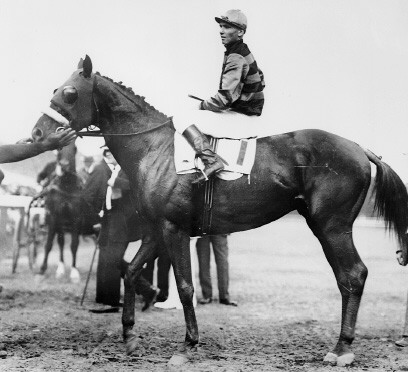|
Vigil II
Vigil (foaled 1920) was an American Thoroughbred racehorse best known for winning the 1923 Preakness Stakes in a performance the ''Los Angeles Times'' called "the most brilliant victory in the history of the Preakness." Bred by Arthur B. Hancock, Vigil was a bay horse sired by the Hopeful Stakes winner Jim Gaffney. His dam, Vignola, was a great-granddaughter of the British mare Thoughtless, whose other descendants included the 2000 Guineas winner Adam's Apple. Vigil was purchased and raced by Walter J. Salmon, Sr. His trainer was future U.S. Racing Hall of Fame inductee, Thomas "T.J." Healey 1922 Racing at age two, Vigil won for the first time on July 10, 1922, at Empire City Race Track when he captured the Debut Purse for maidens under jockey James Butwell. He went on to win other minor races including a division of the Baldwin Purse at Saratoga Race Course under jockey Lavelle Ensor. 1923 Overshadowed by Rancocas Stable's Champion colt, Zev, Vigil entered 1923 well d ... [...More Info...] [...Related Items...] OR: [Wikipedia] [Google] [Baidu] |
Stallion (horse)
A stallion is a male horse that has not been gelded ( castrated). Stallions follow the conformation and phenotype of their breed, but within that standard, the presence of hormones such as testosterone may give stallions a thicker, "cresty" neck, as well as a somewhat more muscular physique as compared to female horses, known as ''mares'', and castrated males, called ''geldings''. Temperament varies widely based on genetics, and training, but because of their instincts as herd animals, they may be prone to aggressive behavior, particularly toward other stallions, and thus require careful management by knowledgeable handlers. However, with proper training and management, stallions are effective equine athletes at the highest levels of many disciplines, including horse racing, horse shows, and international Olympic competition. "Stallion" is also used to refer to males of other equids, including zebras and donkeys. Herd behavior Contrary to popular myths, many stallions ... [...More Info...] [...Related Items...] OR: [Wikipedia] [Google] [Baidu] |
Yonkers Raceway
Yonkers Raceway & Empire City Casino, founded in 1899 as the Empire City Race Track, is a one-half-mile standardbred harness racing dirt track and slots racino located at the intersection of Central Park Avenue and Yonkers Avenue in Yonkers, New York, near the New York City border. It is owned by Vici Properties and operated by MGM Resorts International. History Yonkers Raceway, considered a city landmark, was opened in 1899 by William H. Clark's Empire City Trotting Club. Clark died in 1900 and, with much litigation by his heirs over its proposed sale, the track remained closed for most of the next seven years except for special events. One such event occurred in 1902 when Barney Oldfield set a one-mile (1.6 km) record in an automobile at Empire City Race Track. Driving the Ford '999', he covered the distance in 55.54 seconds. The facility was purchased by New York grocery store magnate James Butler, who reopened it for Thoroughbred horse racing in 1907. Among the notable t ... [...More Info...] [...Related Items...] OR: [Wikipedia] [Google] [Baidu] |
Merchants And Citizens Handicap
The Merchants and Citizens Handicap is a discontinued American Thoroughbred horse race which was first run in 1900 at Saratoga Race Course in Saratoga Springs, New York. Open to horses aged three and older, it was contested on dirt. The inaugural event was won by Orville Richards' gelding Charentus and the final running in 1960 by Gustave Ring's Don Poggio. In between them, some of the races most notable winners include U.S. Racing Hall of Fame inductees Roamer, Sir Barton, Exterminator (1921) and Discovery (1935). The 1919 U. S. Triple Crown winner Sir Barton set a world record of 1:55 3/5 for 1 3/16 miles on dirt in winning the August 28, 1920 edition of the Merchants and Citizens Handicap. Records Speed record: * 2:55.80 – Don Poggio (1960) at 1 * 1:54.60 – Reveille Boy (1932) at 1 Most wins: * 2 – Herbert (1901, 1902) * 2 – Sir John Johnson (1909, 1910) Most wins by a jockey: * 6 – Ted Atkinson (1943, 1945, 1947, 1950, 1953, 1955) Most wins by a trainer: ... [...More Info...] [...Related Items...] OR: [Wikipedia] [Google] [Baidu] |
Havre De Grace Handicap
The Havre de Grace Handicap was an American Thoroughbred horse race first run on the August 26, 1912 opening day of the new Havre de Grace Racetrack in Havre de Grace, Maryland. Although most of its runnings would take place in early fall, its final edition was run there on April 30, 1949. Due to Federal government wartime regulations, the 1943 edition was held at Laurel Park and in 1945 at Pimlico Race Course. A race for horses age three old or older, it was run on dirt over a distance of 1 1/8 miles with the exception of 1918 when it was set at 1 mile and 70 yards. From inception through 1939, the race was known as the Havre de Grace Cup Handicap. Historical notes The 38 runnings of the Havre de Grace Handicap produced a number of wins by racing's top horses. The 1915 edition saw ''Life'' magazine co-founder Andrew Miller win with his future U.S. Racing Hall of Fame inductee, Roamer. The 1916 winner, The Finn, had won the 1915 Belmont Stakes and earned American Champion Th ... [...More Info...] [...Related Items...] OR: [Wikipedia] [Google] [Baidu] |
Kentucky Derby
The Kentucky Derby is a horse race held annually in Louisville, Kentucky, United States, almost always on the first Saturday in May, capping the two-week-long Kentucky Derby Festival. The competition is a Grade I stakes race for three-year-old Thoroughbreds at a distance of at Churchill Downs. Colts and geldings carry and fillies . It is dubbed "The Run for the Roses", stemming from the blanket of roses draped over the winner. It is also known in the United States as "The Most Exciting Two Minutes in Sports" or "The Fastest Two Minutes in Sports" because of its approximate duration. It is the first leg of the American Triple Crown, followed by the Preakness Stakes, and then the Belmont Stakes. Of the three Triple Crown races, the Kentucky Derby has the distinction of having been run uninterrupted since its inaugural race in 1875. The race was rescheduled to September 2020 due to the COVID-19 pandemic. The Preakness and Belmont Stakes races had taken hiatuses in 1891� ... [...More Info...] [...Related Items...] OR: [Wikipedia] [Google] [Baidu] |
Sam Hildreth
Samuel Clay Hildreth (May 16, 1866 – September 24, 1929) was an American Thoroughbred horse racing Hall of Fame trainer and owner. Retrieved July 22, 2017 Biography Born in Independence, Missouri, Sam Hildreth began his training career in 1887, competing at racetracks in the with such horses as the good racemare[...More Info...] [...Related Items...] OR: [Wikipedia] [Google] [Baidu] |
United States Triple Crown Of Thoroughbred Racing
In the United States, the Triple Crown of Thoroughbred Racing, commonly known as the Triple Crown, is a series of horse races for three-year-old Thoroughbreds, consisting of the Kentucky Derby, Preakness Stakes, and Belmont Stakes. The three races were inaugurated in different years, the last being the Kentucky Derby in 1875. The Triple Crown Trophy, commissioned in 1950 but awarded to all previous winners as well as those after 1950, is awarded to a horse who wins all three races and is thereafter designated as a Triple Crown winner. The races are traditionally run in May and early June of each year, although global events have resulted in schedule adjustments, such as in 1945 and 2020. The first winner of all three Triple Crown races was Sir Barton in 1919. Some journalists began using the term ''Triple Crown'' to refer to the three races as early as 1923, but it was not until Gallant Fox won the three events in 1930 that Charles Hatton of the '' Daily Racing Form'' put t ... [...More Info...] [...Related Items...] OR: [Wikipedia] [Google] [Baidu] |
Havre De Grace Racetrack
The Havre de Grace Racetrack was an American horse racing track on Post Road in Havre de Grace, Harford County, Maryland. Nicknamed "The Graw," it operated from August 24, 1912, to 1950. For a time, it was owned by the Harford Agricultural and Breeders Association and also by the notorious gambler Arnold Rothstein. The Havre de Grace Handicap was one of the important races in the American northeast for many years. Its winners include U.S. Racing Hall of Fame inductees Roamer, Crusader, Seabiscuit, Sun Beau, Equipoise, and Challedon. Some Hall of Fame horses lost this race. In the 1919 running, Cudgel beat two Hall of Famers: Exterminator and Triple Crown champion Sir Barton. On September 29, 1920, Man o' War won the Potomac Handicap at Havre de Grace. His son, U.S. Triple Crown winner War Admiral, won his first race here on April 25, 1936. The track was located halfway between the cities of Philadelphia and Washington, D.C. In the 1940s, it began losing customers to ... [...More Info...] [...Related Items...] OR: [Wikipedia] [Google] [Baidu] |
Maryland
Maryland ( ) is a state in the Mid-Atlantic region of the United States. It shares borders with Virginia, West Virginia, and the District of Columbia to its south and west; Pennsylvania to its north; and Delaware and the Atlantic Ocean to its east. Baltimore is the largest city in the state, and the capital is Annapolis. Among its occasional nicknames are '' Old Line State'', the ''Free State'', and the '' Chesapeake Bay State''. It is named after Henrietta Maria, the French-born queen of England, Scotland, and Ireland, who was known then in England as Mary. Before its coastline was explored by Europeans in the 16th century, Maryland was inhabited by several groups of Native Americans – mostly by Algonquian peoples and, to a lesser degree, Iroquoian and Siouan. As one of the original Thirteen Colonies of England, Maryland was founded by George Calvert, 1st Baron Baltimore, a Catholic convert"George Calvert and Cecilius Calvert, Barons Baltimore" William Hand Browne, ... [...More Info...] [...Related Items...] OR: [Wikipedia] [Google] [Baidu] |
Harry Payne Whitney
Harry Payne Whitney (April 29, 1872 – October 26, 1930) was an American businessman, thoroughbred horse breeder, and member of the prominent Whitney family. Early years Whitney was born in New York City on April 29, 1872, as the eldest son of Flora Payne and William C. Whitney (1841–1904), a very wealthy businessman and United States Secretary of the Navy. Whitney was the elder brother of William Payne Whitney (1876–1927). His sister Pauline Payne Whitney (1874–1916) married Almeric Hugh Paget, 1st Baron Queenborough (1861–1949), and his youngest sister Dorothy Payne Whitney (1887–1968) was married to Willard Dickerman Straight (1880–1918), and later to Leonard Knight Elmhirst (1893–1974) after Straight's death. Whitney studied at Groton School in Groton, Massachusetts, then attended Yale University, graduating in 1894. He was a member of the Skull and Bones. After Yale, he spent two years at Columbia Law School, but he never finished the course and decided t ... [...More Info...] [...Related Items...] OR: [Wikipedia] [Google] [Baidu] |
Zev (horse)
Zev (1920–1943) was an American thoroughbred horse racing Champion and National Museum of Racing and Hall of Fame inductee. Background A brown colt, Zev was sired by The Finn and was out of the mare Miss Kearney (by Planudes). Bred by the famous horseman John E. Madden, Zev was owned by the Rancocas Stable of Harry F. Sinclair, the founder of Sinclair Oil, who was a central figure in the Teapot Dome scandal and served time in prison. Sinclair named the horse in honor of his friend and personal lawyer, Colonel James William (also known as J.W.) Zeverly. Racing career 1922: Two-year-old season Trained by Sam Hildreth, as a two-year-old Zev won five of his twelve races, finished second on four occasions, and was a Champion colt of 1922.''The Bloodhorse.com'' Champion's history charts ... [...More Info...] [...Related Items...] OR: [Wikipedia] [Google] [Baidu] |
Rancocas Farm
Rancocas Farm was an American thoroughbred horse racing stud farm and racing stable located on Monmouth Road ( County Road 537) in the Jobstown section of Springfield Township, Burlington County, New Jersey. Pierre Lorillard IV The farm was founded in the 1870s by the wealthy tobacco manufacturer Pierre Lorillard IV (1833-1901) who had a home in the town of Rancocas, now a part of Westampton Township, New Jersey. Lorillard built his stable into one of the premier thoroughbred breeding and training operations in the United States. Lorillard bred Parole, one of the three greatest runners of the 1870s. In 1881, Lorillard's horse Iroquois became the first American-owned and -bred horse to win a European classic race. Ridden by the champion English jockey, Fred Archer, Iroquois won The Derby then went on to also capture the St. Leger Stakes. Lily A. Livingston On the death of Pierre Lorillard, Rancocas Stable was inherited by Lillian "Lily" Barnes-Allen-Livingston. She later sold i ... [...More Info...] [...Related Items...] OR: [Wikipedia] [Google] [Baidu] |






